

The International Scientific Association for Probiotics and Prebiotics (ISAPP) consensus statement on fermented foods. Clostridioides difficile Infection: Is There a Role for Diet and Probiotics? The International Scientific Association for Probiotics and Prebiotics (ISAPP) consensus statement on the definition and scope of synbiotics. Effects of Probiotics in Conditions or Infections Similar to COVID-19 on Health Outcomes: An Evidence Analysis Center Scoping Review - Journal of the Academy of Nutrition and Dietetics. Probiotics and Preterm Infants: A Position Paper by the ESPG... : Journal of Pediatric Gastroenterology and Nutrition. Probiotics of Diverse Origin and Their Therapeutic Applications: A Review: Journal of the American College of Nutrition: Vol 0, No 0. Translating probiotic science into practice - Chambers - 2019 - Nutrition Bulletin.
From Probiotics to Psychobiotics: Live Beneficial Bacteria Which Act on the Brain-Gut Axis. 1.
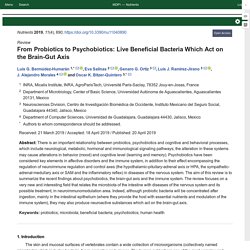
Introduction The skin and mucosal surfaces of vertebrates contain a wide collection of microorganisms (collectively named microbiota) which includes bacteria, fungi, parasites and viruses. The human gut harbors one of the most complex and abundant ecosystems composed of up to 1013–1014 microorganisms which is between 1 to 10 times more than the number of eukaryotic cells in the body [1,2]. The collective adult human gut microbiota is composed of a maximum of 500–1000 bacterial species [1,3,4].
Hundreds of years of co-evolution have led to a mutual symbiosis between the host and gut microbiome. Later in life, microbial colonization of the intestine has a significant impact on the host neurophysiology, behavior and function of the nervous system [9,10,11]. Dinan and coworkers [15] originally defined psychobiotics as probiotics that, upon ingestion in adequate amounts, yield positive influence on mental health. 2. Figure 1. 3. Figure 2. Figure 3. 4. Figure 4. Figure 5.
Figure 6. The pros, cons, and many unknowns of probiotics. Probiotic Foods and Supplements Interventions for Metabolic Syndromes: A Systematic Review and Meta-Analysis of Recent Clinical Trials - FullText - Annals of Nutrition and Metabolism 2019, Vol. 74, No. 3. The Role of Probiotics and Prebiotics in the Prevention and Treatment of Obesity. 2.
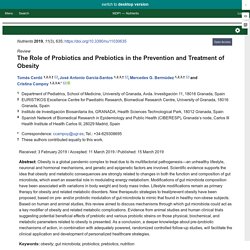
Pathophysiology of Obesity Obesity is a worldwide epidemiologic syndrome characterized by fat mass accumulation, mainly visceral fat. The prevalence of obesity has doubled in the last three decades; in 2016, according to the WHO, more than 1900 million (39%) people above 18 years old were overweight and 600 million (13%) were classified as obese [14]. Moreover, childhood obesity has grown exponentially over the past 25 years in infants and young children (aged 0–5 years), having increased from 32 million globally in 1990 to 42 million in 2013 and being now the most prevalent nutritional disorder globally among children [15]. Obesity is now declared as a current global epidemic by the WHO.
Obesity is assessed in practice by body mass index (BMI) or the ratio of waist to hip circumference. However, the dramatic rise in the prevalence of obesity over the past decades has turned attention towards the environment. 3. 4. 5. Table 1. Table 2. 7. Figure 2. 8. Probiotics to prevent infantile colic - Ong, TG - 2019. Probiotics on Pediatric Functional Gastrointestinal Disorders. A review of probiotic supplementation in healthy adults: helpful or hype? Microbial Therapeutics Designed for Infant Health. Introduction From birth through to the initial stages of weaning, intestinal microbial composition has a significant impact on infant gut health.

Recent advances in culture-independent sequencing technologies has allowed for the identification of key microbial species involved in the initial colonization process, including those facultative anaerobes such as Streptococcus, Staphylococcus, and Enterobacter spp. (1, 2). Commercial Probiotic Products: A Call for Improved Quality... : Journal of Pediatric Gastroenterology and Nutrition. What Is Known * The effects of probiotics seem to be strain-specific and dose-dependent. * Manufacturing of probiotic products can affect microbial survival, growth, and viability. * Probiotic products are mostly categorized as food or dietary supplements, which, unlike drugs, have to comply with significantly less stringent regulatory criteria.
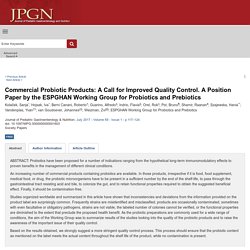
What Is New * Our review provides evidence on the inadequate quality of commercial probiotic products, with regard to microorganism specification, their numbers, functional properties, and the presence of contaminating microorganisms. * More stringent quality control procedures are suggested, which should be mandatory for products prescribed for specific clinical situations, and for use in vulnerable populations such as infants and children. Another emerging issue related to the product quality is the problem of substrate contamination.
Regulation over probiotic products varies in respect to legal or statutory position. Contamination (43,45–48,53) 1. Probiotics in Helicobacter pylori eradication therapy: Systematic review and network meta-analysis - ScienceDirect. Background Several probiotics were effective in the eradication treatment for Helicobacter pylori (Hp), but their comparative efficacy was unknown.
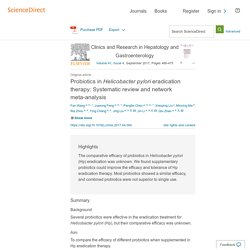
Aim To compare the efficacy of different probiotics when supplemented in Hp eradication therapy. Methods A comprehensive search was conducted to identify all relevant studies in multiple databases and previous meta-analyses. Results One hundred and forty studies (44 English and 96 Chinese) were identified with a total of 20,215 patients, and more than 10 probiotic strategies were supplemented in Hp eradication therapy. Conclusions Compared to placebo, most probiotic strategies were effective when supplemented in Hp eradication therapy. Probiotic use in at-risk populations. Background •Probiotics, although typically not sold as drugs, are sometimes used by hospitalized or other at-risk people.
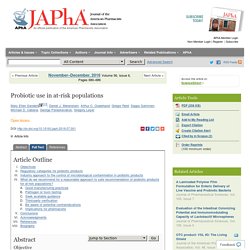
Findings. Indications and Recommendations by Societies and Institution... : Journal of Pediatric Gastroenterology and Nutrition. Functional gastrointestinal disorders (FGIDs) are defined as a variable combination of age-dependent, chronic or recurrent gastrointestinal symptoms not explained by structural or biochemical abnormalities.
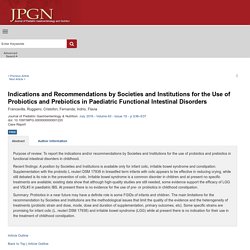
The term functional emphasizes that many of symptoms are not related to a disease state but rather should be interpreted as an exaggerated response to an otherwise normal internal or external cues. Use of Probiotics for Management of Acute Gastroenteritis: A Position Paper by the ESPGHAN Working Group for Probiotics and Prebiotics. Acute gastroenteritis (AGE) has been defined by the European Society for Pediatric Gastroenterology, Hepatology, and Nutrition (ESPGHAN) as a decrease in the consistency of stools (loose or liquid) and/or an increase in the frequency of evacuations (typically ≥3 in 24 hours), with or without fever or vomiting (1a).
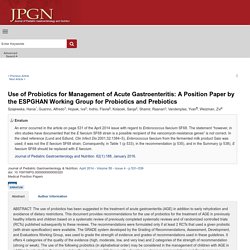
Diarrhea typically lasts <7 days and not longer than 14 days. In Europe, it is estimated that the incidence of AGE ranges from 0.5 to 1.9 episodes per child per year in children up to 3 years of age (1a). Rehydration is the key treatment and should be applied as soon as possible. Regular feeding should not be interrupted and should be carried on immediately after initial rehydration. Drugs are generally not necessary, although some have an impact on the duration and symptoms of AGE.